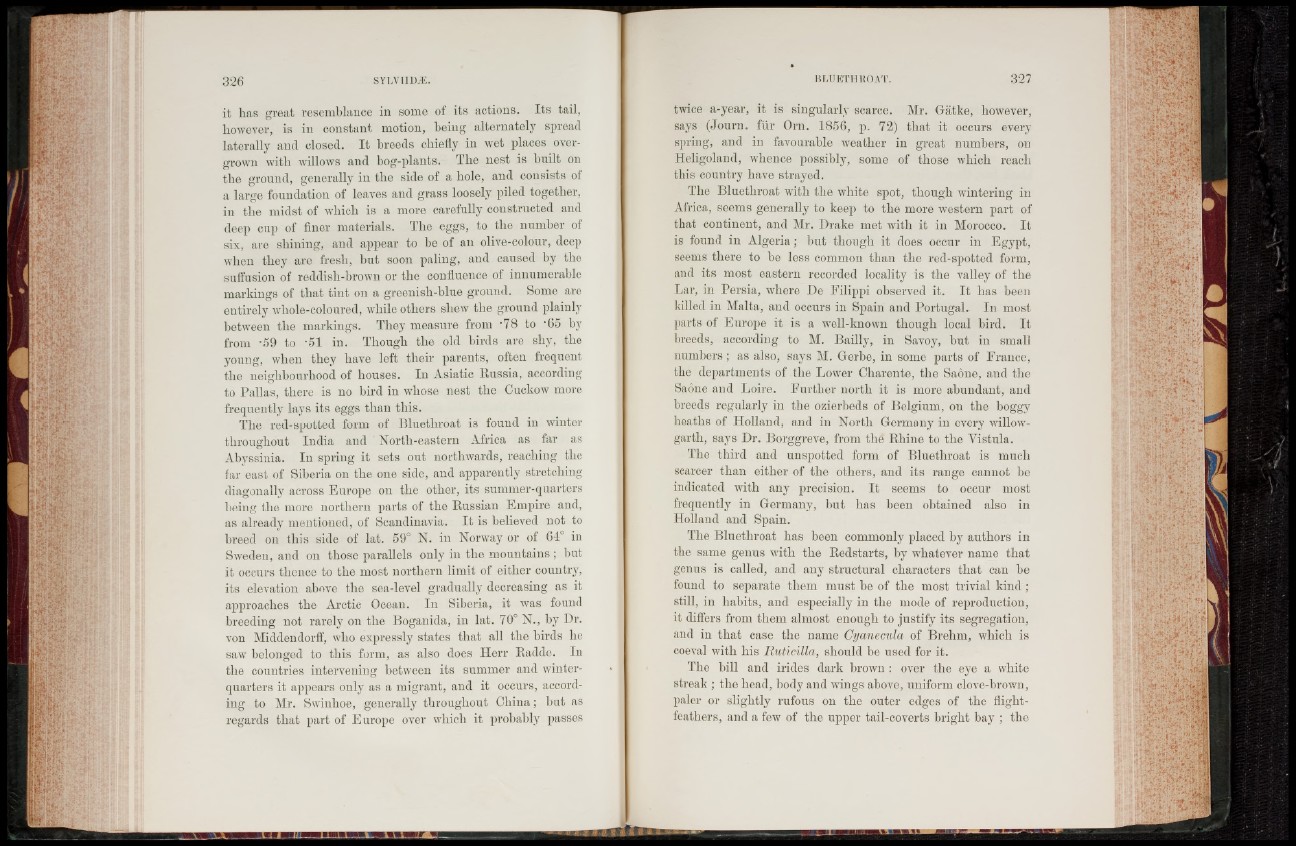
it has great resemblance in some of its actions. Its tail,
however, is in constant motion, being alternately spread
laterally and closed. I t breeds chiefly in wet places overgrown
with willows and bog-plants. The nest is built on
the ground, generally in the side of a bole, and consists of
a large foundation of leaves and grass loosely piled together,
in the midst of which is a more carefully constructed and
deep cup of finer materials. The eggs, to the number of
six, are shining, and appear to be of an olive-colour, deep
when they are fresh, but soon paling, and caused by the
suffusion of reddish-brown or the confluence of innumerable
markings of that tint on a greenish-blue ground. Some are
entirely whole-coloured, while others shew the ground plainly
between the markings. They measure from "78 to -65 by
from -59 to -51 in. Though the old birds are shy, the
young, when they have left their parents, often frequent
the neighbourhood of houses. In Asiatic Russia, according
to Pallas, there is no bird in whose nest the Cuckow more
frequently lays its eggs than this.
The red-spotted form of Bluethroat is found in winter
throughout India and North-eastern Africa as far as
Abyssinia. In spring it sets out northwards, reaching the
far east of Siberia on the one side, and apparently stretching
diagonally across Europe on the other, its summer-quarters
being the more northern parts of the Russian Empire and,
as already mentioned, of Scandinavia. I t is believed not to
breed on this side of lat. 59° N. in Norway or of G4° in
Sweden, and on those parallels only in the mountains; hut
it occurs thence to the most northern limit of either country,
its elevation above the sea-level gradually decreasing as it
approaches the Arctic Ocean. In Siberia, it was found
breeding not rarely on the Boganida, in lat. 70° N., by Dr.
von Middendorff, who expressly states that all the birds he
saw belonged to this form, as also does Herr Radde. In
the countries intervening between its summer and winter-
quarters it appears only as a migrant, and it occurs, according
to Mr. Swinhoe, generally throughout China; hut as
regards that part of Europe over which it probably passes
twice a-year, it is singularly scarce. Mr. Gàtke, however,
says (Journ. fiir Orn. 1856, p. 72) that it occurs every
spring, and in favourable weather in great numbers, on
Heligoland, whence possibly, some of those which reach
this country have strayed.
The Bluethroat with the white spot, though wintering in
Africa, seems generally to keep to the more western part of
that continent, and Mr. Drake met with it in Morocco. It
is found in Algeria ; but though it does occur in Egypt,
seems there to he less common than the red-spotted form,
and its most eastern recorded locality is the valley of the
Lar, in Persia, where De Filippi observed it. It has been
killed in Malta, and occurs in Spain and Portugal. In most
parts of Europe it is a well-known though local bird. It
breeds, according to M. Bailly, in Savoy, but in small
numbers ; as also, says M. Gerbe, in some parts of France,
the departments of the Lowrer Charente, the Saône, and the
Saône and Loire. Further north it is more abundant, and
breeds regularly in the ozierbeds of Belgium, on the boggy
heaths of Holland, and in North Germany in every willow-
garth, says Dr. Borggreve, from the Rhine to the Vistula.
The third and unspotted form of Bluethroat is much
scarcer than either of the others, and its range cannot he
indicated with any precision. It seems to occur most
frequently in Germany, but has been obtained also in
Holland and Spain.
The Bluethroat lias been commonly placed by authors in
the same genus with the Redstarts, by whatever name that
genus is called, and any structural characters that can be
found to separate them must he of the most trivial kind ;
still, in habits, and especially in the mode of reproduction,
it differs from them almost enough to justify its segregation,
and in that case the name Cyanecula of Brehm, which is
coeval with his Ruticilla, should be used for it.
The hill and irides dark brown : over the eye a white
streak ; the head, body and wings above, uniform clove-brown,
paler or slightly rufous on the outer edges of the flight-
feathers, and a few of the upper tail-coverts bright bay ; the